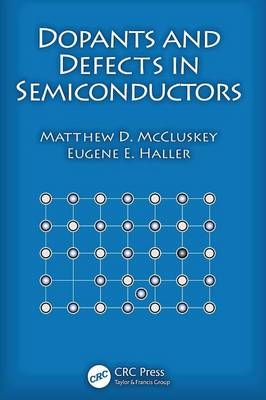
Dopants and Defects in Semiconductors
Crc Press Inc (Verlag)
978-1-4398-3152-6 (ISBN)
- Titel erscheint in neuer Auflage
- Artikel merken
The authors first present introductory concepts, including basic semiconductor theory, defect classifications, crystal growth, and doping. They then explain electrical, vibrational, optical, and thermal properties. Moving on to characterization approaches, the text concludes with chapters on the measurement of electrical properties, optical spectroscopy, particle-beam methods, and microscopy.
By treating dopants and defects in semiconductors as a unified subject, this book helps define the field and prepares students for work in technologically important areas. It provides students with a solid foundation in both experimental methods and the theory of defects in semiconductors.
Matthew D. McCluskey is a professor in the Department of Physics and Astronomy and Materials Science Program at Washington State University. He earned a Ph.D. in physics from the University of California, Berkeley. His research interests include defects in semiconductors, materials under high pressure, shock compression of semiconductors, and vibrational spectroscopy. Eugene E. Haller is a professor in the Graduate School at the University of California, Berkeley. He is a member of the National Academy of Engineering and earned a Ph.D. in solid state and applied physics from the University of Basel. His research areas include far-infrared detectors, isotopically controlled semiconductors, semiconductor nanocrystals, and semiconductor growth, characterization, and processing.
Semiconductor Basics
Historical Overview
Crystal Structure
Phonons
Band Structure
Electrons and Holes
Optical Properties
Electronic Transport
Examples of Semiconductors
Devices
Defect Classifications
Structure and Symmetry
Energy Levels
Examples of Native Defects
Examples of Nonhydrogenic Impurities
Dislocations
Metal-Semiconductor Junctions
The Metal-Oxide-Semiconductor (MOS) Junction
Crystal Growth and Doping
Bulk Crystal Growth
Dopant Incorporation during Bulk Crystal Growth
Thin Film Growth
Liquid Phase Epitaxy (LPE)
Chemical Vapor Deposition (CVD)
Molecular Beam Epitaxy (MBE)
Alloying
Doping by Diffusion
Ion Implantation
Annealing and Dopant Activation
Neutron Transmutation
Electronic Properties
Hydrogenic Model
Wave Function Symmetry
Donor and Acceptor Wave Functions
Deep Levels
Carrier Concentrations as a Function of Temperature
Freeze-Out Curves
Scattering Processes
Impurity Conduction
Spintronics
Vibrational Properties
Phonons
Defect Vibrational Modes
Infrared Absorption
Interactions and Lifetimes
Raman Scattering
Wave Functions and Symmetry
Oxygen in Silicon and Germanium
Impurity Vibrational Modes in GaAs
Hydrogen Vibrational Modes
Optical Properties
Free-Carrier Absorption and Reflection
Lattice Vibrations
Dipole Transitions
Band-Gap Absorption
Carrier Dynamics
Exciton and Donor–Acceptor Emission
Isoelectronic Impurities
Lattice Relaxation
Transition Metals
Thermal Properties
Defect Formation
Charge State and Chemical Potential
Diffusion
Microscopic Mechanisms of Diffusion
Self-Diffusion
Dopant Diffusion
Quantum-Well Intermixing
Electrical Measurements
Resistivity and Conductivity
Methods of Measuring Resistivity
Hall Effect
P-n and Schottky Junctions
Capacitance–Voltage (C–V) Profiling
Carrier Generation and Recombination
Deep-Level Transient Spectroscopy (DLTS)
Minority Carriers and Deep-Level Transient Spectroscopy (DLTS)
Minority Carrier Lifetime
Thermoelectric Effect
Optical Spectroscopy
Absorption
Emission
Raman Spectroscopy
Fourier Transform Infrared (FTIR) Spectroscopy
Photoconductivity
Time-Resolved Techniques
Applied Stress
Electron Paramagnetic Resonance (EPR)
Optically Detected Magnetic Resonance (ODMR)
Electron Nuclear Double Resonance (ENDOR)
Particle-Beam Methods
Rutherford Backscattering Spectrometry (RBS)
Ion Range
Secondary Ion Mass Spectrometry (SIMS)
X-Ray Emission
X-Ray Absorption
Photoelectric Effect
Electron Beams
Positron Annihilation
Muons
Perturbed Angular Correlation Spectroscopy (PACS)
Nuclear Reactions
Microscopy and Structural Characterization
Optical Microscopy
Scanning Electron Microscopy (SEM)
Cathodoluminescence (CL)
Electron Beam Induced Current (EBIC) Microscopy
Diffraction
Transmission Electron Microscopy (TEM)
Scanning Probe Microscopy (SPM)
Physical Constants
References appear at the end of each chapter.
| Erscheint lt. Verlag | 30.3.2012 |
|---|---|
| Zusatzinfo | N/A; Over 500; 22 Tables, black and white; 244 Illustrations, black and white |
| Verlagsort | Bosa Roca |
| Sprache | englisch |
| Maße | 178 x 254 mm |
| Gewicht | 839 g |
| Themenwelt | Technik ► Elektrotechnik / Energietechnik |
| Technik ► Maschinenbau | |
| ISBN-10 | 1-4398-3152-1 / 1439831521 |
| ISBN-13 | 978-1-4398-3152-6 / 9781439831526 |
| Zustand | Neuware |
| Haben Sie eine Frage zum Produkt? |
aus dem Bereich



